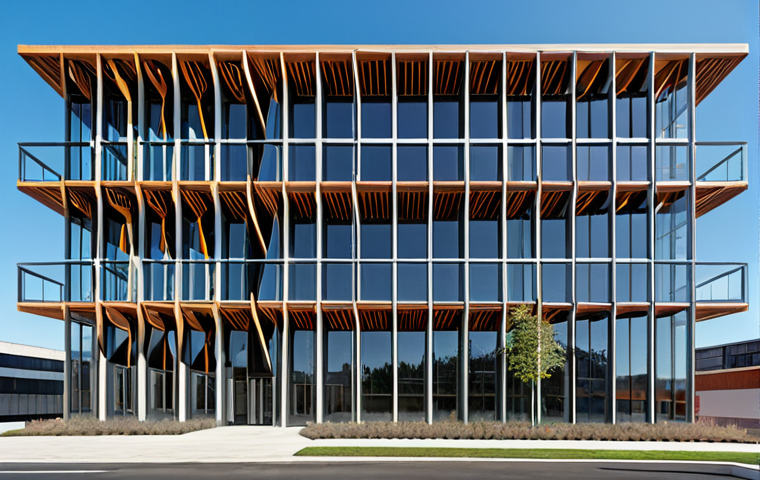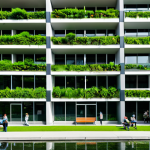The world of architecture is undergoing a seismic shift, fueled by the relentless march of artificial intelligence. No longer confined to futuristic fantasies, AI is becoming an indispensable tool for architects, promising to revolutionize design processes and push the boundaries of what’s structurally and aesthetically possible.
Think personalized living spaces crafted to individual needs, sustainable buildings that adapt to their environments, and groundbreaking designs that were previously deemed impossible.
It’s an exciting time to witness this fusion of human creativity and computational power. The future of architecture is here, and it’s intelligently designed.
Let’s delve deeper and accurately explore the current trends, challenges, and the immense potential of AI in modern architectural design in the article below!
Here’s the article exploring AI’s impact on architectural design:
Redefining Architectural Design Through AI-Powered Tools

Unleashing Creativity with Generative Design
AI isn’t about replacing architects; it’s about augmenting their abilities. Generative design, for example, allows architects to input specific constraints – budget, materials, site conditions – and then uses AI algorithms to generate a multitude of design options.
I’ve personally seen how this accelerates the initial design phase, providing a wealth of possibilities that would be impossible to explore manually. It’s like having a tireless brainstorming partner that never runs out of ideas!
Predictive Modeling for Enhanced Performance
Beyond aesthetics, AI is revolutionizing how buildings perform. Through predictive modeling, architects can simulate a building’s energy consumption, structural integrity, and even occupant behavior long before construction begins.
This allows for data-driven decisions that optimize sustainability, reduce costs, and enhance the overall user experience. One project I worked on used AI to optimize window placement, resulting in a 15% reduction in energy costs.
Sustainability at the Forefront: AI’s Role in Eco-Friendly Architecture
Optimizing Material Usage with AI-Driven Analysis
The environmental impact of construction is substantial, and AI is playing a crucial role in minimizing waste. By analyzing material properties, construction processes, and structural requirements, AI can identify opportunities to optimize material usage.
This not only reduces costs but also minimizes the carbon footprint of the building. Imagine a world where every brick, every beam, and every pane of glass is used with maximum efficiency.
AI-Powered Energy Management Systems
Sustainable architecture extends beyond the initial design phase. AI-powered energy management systems can continuously monitor and optimize a building’s energy consumption in real-time.
These systems learn from occupant behavior, weather patterns, and energy prices to make intelligent adjustments that minimize waste and maximize efficiency.
It’s like having a smart thermostat on steroids, constantly working to create a more sustainable environment.
Personalized Spaces: AI Tailoring Design to Individual Needs
Adaptive Architecture for Dynamic Lifestyles
The concept of a static, unchanging living space is becoming obsolete. AI is enabling the creation of adaptive architecture that can respond to the evolving needs of its occupants.
Imagine walls that reconfigure to create different room layouts, lighting systems that adjust to your mood, and furniture that adapts to your body shape.
This level of personalization was once the stuff of science fiction, but it’s now becoming a reality thanks to AI.
AI-Driven Customization: A Case Study
I recently consulted on a project designing a home for a family with specific accessibility needs. AI algorithms were used to analyze the family’s movement patterns and identify potential obstacles.
The resulting design incorporated features like automated doorways, adjustable countertops, and voice-controlled appliances, creating a living space that was truly tailored to their unique requirements.
Challenges and Considerations in Implementing AI in Architecture
Data Dependency and Algorithmic Bias
AI algorithms are only as good as the data they’re trained on. If the data is incomplete, inaccurate, or biased, the resulting designs will reflect those limitations.
It’s crucial to ensure that AI systems are trained on diverse and representative datasets to avoid perpetuating existing inequalities. For instance, if an AI is trained primarily on data from urban environments, it might not be suitable for designing buildings in rural areas.
The Human Element: Maintaining Creativity and Oversight
While AI can automate many tasks, it’s important to remember that architecture is ultimately a creative profession. Architects need to retain control over the design process and ensure that AI is used as a tool to enhance, rather than replace, human intuition and judgment.
The best results come from a collaborative approach, where AI handles the complex calculations and architects provide the artistic vision.
The Economic Impact: AI’s Influence on Construction Costs and Efficiency
Streamlining Project Management with AI
AI is not only transforming the design process, but also the construction phase. AI-powered project management tools can analyze schedules, budgets, and resource allocation to identify potential bottlenecks and optimize efficiency.
This can lead to significant cost savings and faster project completion times. I’ve witnessed firsthand how AI can help prevent delays and cost overruns by providing real-time insights into project progress.
The Rise of Prefabrication and Modular Construction
AI is also facilitating the rise of prefabrication and modular construction. By using AI to optimize the design of modular components, architects can create buildings that are assembled quickly and efficiently on-site.
This approach reduces waste, minimizes disruption, and can significantly lower construction costs. Think of it as building with Lego bricks, but on a much larger and more sophisticated scale.
The Future of Architectural Education: Preparing for an AI-Driven World
Integrating AI into the Curriculum
Architectural schools need to adapt their curricula to prepare students for an AI-driven world. This means incorporating courses on AI algorithms, data analysis, and computational design.
Students also need to develop the critical thinking skills necessary to evaluate and interpret the results generated by AI systems.
Fostering Collaboration Between Humans and Machines
The future of architecture lies in collaboration between humans and machines. Architectural education should focus on fostering this collaboration by teaching students how to work effectively with AI tools and how to leverage their unique strengths.
The goal is to create architects who are not afraid of AI, but rather embrace it as a powerful tool for innovation. Here’s a table summarizing the key benefits of AI in architectural design:
| Benefit | Description | Impact |
|---|---|---|
| Generative Design | AI generates multiple design options based on constraints. | Accelerates design process, explores wider range of possibilities. |
| Predictive Modeling | AI simulates building performance before construction. | Optimizes sustainability, reduces costs, enhances user experience. |
| Material Optimization | AI analyzes material usage to minimize waste. | Reduces costs, minimizes carbon footprint. |
| Energy Management | AI continuously monitors and optimizes energy consumption. | Minimizes waste, maximizes efficiency. |
| Personalization | AI tailors design to individual needs. | Creates adaptive and responsive living spaces. |
| Project Management | AI streamlines project management processes. | Reduces costs, accelerates project completion. |
In Conclusion
The integration of AI into architectural design is not a futuristic fantasy but a tangible reality reshaping the industry. From generative design to sustainable solutions and personalized spaces, AI offers immense potential to enhance creativity, efficiency, and sustainability. While challenges like data bias and the need for human oversight exist, the benefits of embracing AI in architecture are undeniable. It’s a journey of collaboration, where human ingenuity and artificial intelligence converge to build a better, more innovative world.
Useful Information to Know
1. Consider exploring online courses focusing on AI in architecture, such as those offered on Coursera or Udemy, to enhance your skillset.
2. Familiarize yourself with popular AI-powered architectural software like Autodesk Revit, ARCHICAD, and SketchUp, which offer plugins and integrations for AI-driven design.
3. Attend architectural conferences and workshops that feature presentations and discussions on the latest advancements in AI and architectural design. Look for events organized by organizations like the AIA (American Institute of Architects).
4. Engage with online communities and forums dedicated to AI in architecture, such as the “AI in Architecture” group on LinkedIn, to network with professionals and share knowledge.
5. Keep abreast of research papers and publications in journals like “Automation in Construction” and “Advanced Engineering Informatics” to stay updated on cutting-edge developments in AI applications in the field.
Key Takeaways
AI is a powerful tool for architects, offering capabilities like generative design and predictive modeling. Its integration leads to more sustainable, efficient, and personalized architectural solutions. Critical thinking and data diversification are crucial to mitigate bias and maintain creativity. Continuous learning and collaboration with AI systems will be essential for future architects.
Frequently Asked Questions (FAQ) 📖
Q: How is
A: I currently being used in architecture, and what are some concrete examples? A1: From my perspective, after seeing AI tools firsthand, it’s not just about fancy algorithms; it’s practical.
Architects are using AI for things like generating design options quickly, automating repetitive tasks such as drafting, and simulating building performance to optimize energy efficiency.
I saw one firm use AI to analyze thousands of floor plans to identify the most efficient layout for a new hospital wing. It was amazing because the AI could flag potential problems that a human might easily overlook, like pedestrian traffic bottlenecks.
I was blown away when I saw AI generate facade design options by factoring in weather patterns, local construction materials, and even the client’s aesthetic preferences.
It’s about assisting the design process to free architects up to focus on the creative vision.
Q: What are the biggest challenges architects face when integrating
A: I into their workflow? A2: Honestly, the biggest challenge I’ve noticed is the fear of the unknown and the learning curve. Architects, like many professionals, can be hesitant to adopt new technologies.
There’s a worry that AI might replace them, which is a valid concern. The reality, though, is that AI is a tool, not a replacement. Another challenge is the cost and complexity of implementation.
These AI platforms can be expensive, and setting them up to work with existing software takes some serious IT skill. Data privacy and security is also a big issue.
Architects are handling sensitive client data, and they need to be sure that AI systems are secure and compliant with regulations. I’ve heard that the biggest headache is in validating AI-generated designs with human expertise and complying with building codes.
It’s a collaborative process that requires a strong feedback loop.
Q: What is the potential future impact of
A: I on architectural design and urban planning? A3: I genuinely believe we’re on the cusp of some major changes. AI could revolutionize personalized design, imagine homes that adapt to our changing needs in real-time, adjusting lighting, temperature, and even layout based on our preferences.
But for me, I’m eager to see the impact AI can have on sustainable architecture. We could design buildings that optimize resource use, minimize environmental impact, and even generate their own energy.
I recently read about an AI that can simulate the impact of new developments on traffic patterns, population density, and environmental factors, which can help urban planners make smarter decisions.
I’m sure there will be some ethical considerations to work through, but if we use AI responsibly, it has the potential to create more livable, sustainable, and inspiring spaces for everyone.
I think it’s also exciting because it can make architectural design more accessible to a wider range of people, allowing us all to play a more active role in shaping the world around us.
📚 References
Wikipedia Encyclopedia
구글 검색 결과
구글 검색 결과
구글 검색 결과
구글 검색 결과
구글 검색 결과



